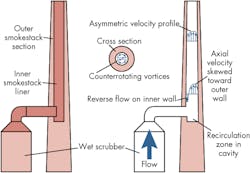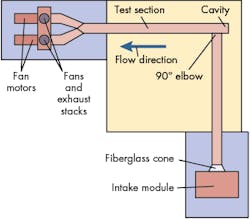Smokestack Simulator Will Help Uncover How to Accurately Measure Emissions
Operators of U.S. coal-fired power plants can only get figures for the amount of carbon dioxide coming out of their smokestacks that are accurate to within 10 to 20%. This means no one in the U.S. really knows how much CO2 is being emitted into the atmosphere. To solve this problem, engineers at the National Institute of Standards and Technology (NIST) are building a 164-ft-long horizontal smokestack model, the Scale-Model Smokestack Simulator.
It will be fully instrumented by the end of the year, which will let researchers determine the most-precise methods for monitoring the amount and type of emissions going up the smokestacks at coal-fired power plants and other industrial sites. The goal of the project is to find a way to measure CO2 emissions to within 1% for a reasonable cost. This became more important this past June when the EPA began drafting plans to cut power-plant emissions 30% by 2030.
About two-thirds of plant managers currently measure emissions with ultrasonic systems made up of two transmitter/receiver units mounted at different heights in the stack. A sound signal traveling from one to the other speeds up if it’s traveling in the direction of the gas flow. Conversely, the signal slows if traveling against the flow. The difference in transit times across that single path is used to calculate the flow velocity in the stack. Multiplying flow velocity by the area of the smokestack’s cross section yields flow volume. And flow volume is used to calculate emission volumes.
But flow in smoke stacks is turbulent and inhomogeneous, caused partially by the fact that gases usually take a 90° turn as they travel from the scrubber to the smokestack. Even once inside the stack, flow does not go straight up. It swirls, introducing errors into velocity measurements.
To simplify the simulator, it is laid out horizontally rather than vertically, and is only 3.3 ft in diameter rather than 33 ft, the average diameter of an industrial smokestack. And air rather than flue gases will be sent through the simulator. Air is a good substitute because it is safer and easier to obtain. Plus, in modern coal plants, flue gases travel through a wet scrubber that brings their temperature down to that of the ambient atmosphere before entering the stack.
NIST researchers will use the simulator to test several methods of determining the amount of emissions traveling though smokestacks, including:
- A laser Doppler anemometer that measures the interference between pitot tubes and the smokestack’s walls.
- Computational fluid dynamics to model and predict the flow dependence of swirl generated at the stack entrance and the effects of swirling flows.
- Three and four-path ultrasonic flowmeters.
- Long-wavelength acoustic flowmeters.
- Injecting tracers and measuring their dilution.


